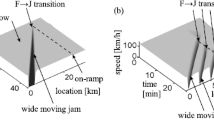Abstract
Transilien, the SNCF branch in charge of operating the main urban railroad network in the area of Paris, faces a regular increase of passenger flows. The planning of railway operations is made carefully through simulation runs which help to assess the timetable stability. However, many disturbances appear and cause train delays. Due to the nature of the railroad network those delays are cumulative and an on-line update of the timetable is not always successful in maintaining the trains schedules. In this tensed context, operators are searching solutions to enhance the use of the infrastructure capacity and achieve a better service quality. A needed step towards this objective is a better understanding of the phenomena of disruptions, in particular because the expansion of congestion is so far not clearly understood. This paper explores the possibility to transpose a traffic flow theory tool, the network fundamental diagram, in the field of dense railroad traffic. Railroad traffic is different from road traffic in many ways: railways are a planned system, traffic volume does not satisfy the continuum hypothesis, stations force stops and the signalization system brings a discrete behavior. Despite those big differences we show how to build a similar tool for a railroad system, the Line Fundamental Diagram (LFD), and how to interpret some obtained shapes for those diagrams. These diagrams give us some means to compare plan and reality. We also identify the limits that have to be overcome to take benefits of the road traffic tools in railroad traffic analysis.







Similar content being viewed by others
References
Buisson C, Ladier C (2009) Exploring the impact of the homogeneity of traffic measurements on the existence of macroscopic fundamental diagrams. Transp Res Rec:127–136
Cassidy M, Jang K, Daganzo C (2011) Macroscopic fundamental diagrams for freeway networks: theory and observation. Transp Res Rec 2260: 8–15
Chiabaut N (2015) Evaluation of a multimodal urban arterial: the passenger macroscopic fundamental diagram. Transp Res Part B
Courbon T, Leclercq L (2011) Cross-comparison of macroscopic fundamental diagram estimation methods. Proced Soc Behav Sci 20:417–426
Daganzo C (2007) Urban gridlock: Macroscopic modeling and mitigation approaches. Transp Res B 41(1):49–62)
Daganzo C, Gayah V, Gonzales E (2011) Macroscopic relations of urban traffic variables: bifurcations, multivaluedness and instability. Transp Res Part B Methodol 45(1): 278–288
Daganzo CF, Geroliminis N (2008) An analytical approximation for the macroscopic fundamental diagram of urban traffic. Transp Res Part B Methodol 42(9):771–781. doi:10.1016/j.trb.2008.06.008
Geroliminis N, Daganzo C (2007) Macroscopic modeling of traffic in cities. Transp Res Board (07-0413)
Geroliminis N, Daganzo CF (2008) Existence of urban-scale macroscopic fundamental diagrams: Some experimental findings. Transp Res Part B Methodol 42(9):759–770. doi:10.1016/j.trb.2008.02.002
Geroliminis N, Sun J (2011) Properties of a well-defined macroscopic fundamental diagram for urban traffic. Transp Res Part B Methodol 45(3):605–617. doi:10.1016/j.trb.2010.11.004
Geroliminis N, Sun J (2011) Properties of a well-defined macroscopic fundamental diagram for urban traffic. Transp Research Part B Methodol 45(3):605–617
Geroliminis N, Zheng N, Ampountolas K (2014) A three-dimensional macroscopic fundamental diagram for mixed bi-modal urban networks. Transp Res Part C EmergTechnol 42:168–181. doi:10.1016/j.trc.2014.03.004
Godfrey J (1969) The mechanism of a road network. Traffic Eng Control 11(7):323–327
Gonzales EJ (2015) Coordinated pricing for cars and transit in cities with hypercongestion. Econ Transp. doi:10.1016/j.ecotra.2015.04.003
Gonzales EJ, Geroliminis N, Cassidy MJ, Daganzo CF (2010) On the allocation of city space to multiple transport modes. Transp Plan Technol 33(8):643–656
Goverde R (2005) Punctuality of railway operations and timetable stability analysis. Ph.D. thesis, Delft University of Technology
Haddad J, Geroliminis N (2012) On the stability of traffic perimeter control in two-region urban cities. Transp Research Part B Methodol 46(9):1159–1176. doi:10.1016/j.trb.2012.04.004
Haddad J, Ramezani M, Geroliminis N (2013) Cooperative traffic control of a mixed network with two urban regions and a freeway. Transp Research Part B Methodol 54:17–36. doi:10.1016/j.trb.2013.03.007
Herman R, Prigogine I (1979) A two-fluid approach to town traffic. Science 204:148–151
Mahmassani HS, Williams JC, Herman R (1984) Investigations of network-level traffic flow relationships: some simulation results. Transp Res Record 971:121–130
Ji Y, Geroliminis N (2012) On the spatial partitioning of urban transportation networks. Transp Research Part B Methodol 46(10):1639–1656. doi:10.1016/j.trb.2012.08.005
Ji Y, Geroliminis N (2012) On the spatial partitioning of urban transportation networks. Transp Research Part B Methodol 46(10):1639–1656
Keyvan-Ekbatani M, Kouvelas A, Papamichail I, Papageorgiou M (2012) Exploiting the fundamental diagram of urban networks for feedback-based gating. Transp Research Part B Methodol 46(10):1393–1403. doi:10.1016/j.trb.2012.06.008
Keyvan-Ekbatani M, Papageorgiou M, Papamichail I (2013) Urban congestion gating control based on reduced operational network fundamental diagrams. Transp Res Part C Emerg Technol 33:74–87. doi:10.1016/j.trc.2013.04.010
Knoop V, Hoogendoorn S, Lint HV (2012) Routing strategies based on the macroscopic fundamental diagram. Transp Res Rec J Transp Res Board 2315:1–10
Lai YC, Liu YH, Lin YJ (2013) Development of base train equivalents for headway-based analytical railway capacity analysis. RailCopenhagen
Nash A, Hurlimann, D (2004) Railroad simulation using opentrack. In: Proceedings of the 9th COMPRail conference (Computers in Railways IX)
Radtke A., Bendfeld JP (2001) Handling of railway operation problems with railsys. In: WCRR-Proceedings, Koln
Saberi M, Mahmassani HS (2012) Exploring the properties of network-wide flow-density relations in a freeway network. Transp Res Rec 2315:153–163
Saberi M, Mahmassani HS, Hou T, Zockaie A (2014) Estimating network fundamental diagram using three-dimensional vehicle trajectories: Extending edie’s definitions of traffic flow variables to networks. Transp Res Rec J Transp Res Board 2422:12–20
UIC (1996) Links between railway infrastructure capacity and the quality of operations. International Union of Railways (UIC code 405)
UIC (2004) Capacity. International Union of Railways (UIC code 406)
Zheng N, Geroliminis N (2013) On the distribution of urban road space for multimodal congested networks. Transp Research Part B Methodol 57:326–341
Acknowledgments
This research is conducted with the benefit of a PhD grant from Agence Nationale de la Recherche Technologique, France. The authors want to thank Ludovic Leclercq and Winnie Daamen for fruitful discussions during the preparation of this paper.
Author information
Authors and Affiliations
Corresponding author
Rights and permissions
About this article
Cite this article
Cuniasse, PA., Buisson, C., Rodriguez, J. et al. Analyzing railroad congestion in a dense urban network through the use of a road traffic network fundamental diagram concept. Public Transp 7, 355–367 (2015). https://doi.org/10.1007/s12469-015-0110-y
Published:
Issue Date:
DOI: https://doi.org/10.1007/s12469-015-0110-y




